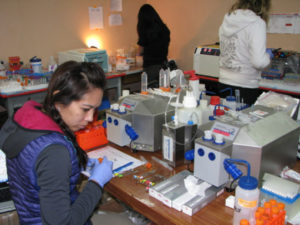From battling stomach bugs to figuring out where to find deionized water, carrying out a scientific expedition in the Andes is no small feat. “We ended up using pressure cookers to sterilize our research equipment,” said former CSU student Catherine Le. “I learned that you need to be creative and adaptive in field research.”
Le was part of a large research team that spent 16 days atop Mount Chacaltaya in Bolivia (elevation 17,785 feet) carrying out one of the most comprehensive studies ever done on how the human body adjusts to high altitude. The AltitudeOmics Project, funded in part by the Department of Defense and the National Institutes of Health, involved 25 researchers from nine universities and six countries.
“When you put it all together, no other study of high-altitude biology comes close to this project in terms of scientific scope or the amount of people involved,” said Adam Chicco, an associate professor in the Department of Biomedical Sciences who led the portion of the study on how muscle metabolism responds to low oxygen in the blood. “It required a lot of teamwork, special planning, flexibility and improvisation.” Chicco’s results were recently published in the Journal of Biological Chemistry.
“Adam Chicco’s paper is an example of all that is good in collaborative science,” said project leader Robert Roach, director of the Altitude Research Center at the University of Colorado-Anschutz. “Many people were needed to make this project happen, both in the field and as we worked for several years on analysis. And this is the first time a study combined the molecular biology of acclimatization with the physiology.”
A mountain of data leads to new insights
To better understand how our bodies adjust to high altitude, where there’s less oxygen, the AltitudeOmics team studied average, healthy people rather than mountaineers. The study participant volunteers from Eugene, Oregon were flown to La Paz, Bolivia and driven to a lab at the top of Mount Chacaltaya, where they carried out normal daily activities for 16 days without supplemental oxygen.
The effects of high altitude and how one’s body adjusts to it varies. “Once we get acclimatized, we can think more clearly, our exercise endurance improves, and we are protected from the most part from high-altitude illnesses,” said Roach.
For Le, experiencing the effects of low oxygen, or hypoxia, felt both frightening and euphoric. She described having a distorted sense of time and feeling as if things were occurring in slow motion. “And in times of exertion, putting one foot in front of the other was a mental feat,” she said.

Several physiological tests were performed on the study participants, along with blood and muscle sampling, before, during and after the high-altitude experience. The next big challenge was to sift through the immense amount of data gathered in the field as well as generated by samples analyzed at Anschutz Medical Campus and CSU’s Proteomics and Metabolomics Facility. Chicco found that changes in muscle energy metabolism at high altitude were different than what was previously thought.
“The prevailing view was that low oxygen forces cells to rely on sugar rather than fat for fuel, since fat requires more oxygen to be burned as energy,” Chicco said. “While this is true under many circumstances, we found that at high altitude, the capacity of muscle to use oxygen for energy is maintained, and fat burning efficiency actually improves. This is accompanied by a breakdown of muscle tissue, which we believe is a primary driver of the metabolic changes we see, rather than low oxygen in the muscle itself.”
Advances in high-altitude research may lead to improved disease management
Hypoxia occurs not only at high altitude but also in chronic pulmonary disease, heart failure, cancers, and other conditions associated with the breakdown of muscle. Chicco and his colleagues believe their findings may lead to a better understanding of how to maintain or improve muscle function in these conditions as well as in people living or exercising in high-altitude environments.
“This research can help us to develop new ideas on how to treat patients with hypoxia-related diseases,” said Le, who graduated with a PhD from the Cell and Molecular Biology Program under Chicco’s mentorship and is now a scientist at Roche Tissue Diagnostics.
Thus far, 19 papers have been published on the AltitudeOmics project, with several more in preparation, containing a broad range of findings.

“I feel very fortunate to have been involved with such an exciting project and eclectic group of scientists,” Chicco said. “As an avid hiker and mountaineer with a research focus on the links between metabolism and physiology, I jumped at the opportunity to combine these interests on such a groundbreaking project. Our results answered long-standing questions and generated new ones that we look forward to exploring in future studies.”
CSU is well positioned to lead future advances in high-altitude research with resources such as its newly renovated Hypo-Hyperbaric Chamber Facility, housed in the Department of Biomedical Sciences, and Human Performance Clinical Research Laboratory in the Department of Health and Exercise Sciences.